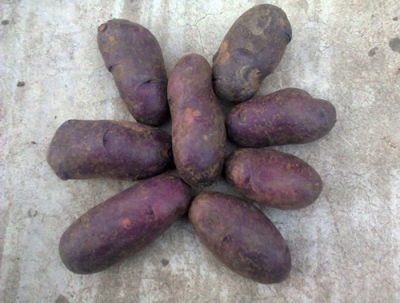
- Appeared when crossing: Black Prince x Blue Danube
- Appointment: dining room
- Tuber weight, g: 100-130
- Peel color: violet with a bluish tinge
- Color of the pulp: white or light cream, possibly interspersed with violet pigment
- Starch content,%: 12−14%
- Tuber shape: oval, often elongated
- Peel structure: very thin, with a glossy sheen
- Eyes: unpainted, few in number
- The soil: fertile
Along with the classic potato varieties, exotic varieties endowed with an unusual color are in high demand. A striking representative of the class of unusual nightshade crops is considered to be the Gypsy potato of national selection.
Breeding history
The Gypsy potato is a variety whose breeding history is legendary. Today Gypsy is considered a folk variety, since there is no information about the author. It was established only that the culture was bred by crossing the Blue Danube and Black Prince varieties. Potatoes are productive, growing in the Central regions, as well as in the southern part of Russia. In addition, the purple vegetable is popular in Ukraine, Belarus and Moldova.
Description of the variety
Gypsy is a fruitful table variety that pleases summer residents with its productivity. It is resistant to most diseases and pests, but it does not tolerate transportation and excessive drought.
Characteristics of the appearance of the bush and root crops
The mid-early potato is a compact, non-sprawling bush, characterized by strong stems with a bluish tinge and moderate foliage, dark green leaves with slightly wavy plates. Under each bush, from 6 to 14 tubers are formed, of which the third part is usually small potatoes.
When blooming, large blue flowers bloom on the bushes, collected in neat inflorescences. Bushes bloom in June.
The gypsy belongs to the medium-fruited species. On average, the mass of tubers is 100-130 g. The shape of the tubers is oval or elongated-oval. The color of the root crop is exotic - purple with a bluish tint and a slight pearlescent tint. The potato peel is very thin, smooth, shiny, with a few superficial eyes.
The thin skin does not protect the tubers from mechanical damage at all, even the crop must be dug out very carefully. That is why potatoes do not tolerate long transportation and cannot be stored for a long time.
Purpose and taste of tubers
Gypsy is famous for its excellent taste. White-creamy flesh with small blotches of purple hue is characterized by a delicate oily consistency. When cutting, the pulp does not darken. The root vegetable has a low starch content, reaching 12-14%. When boiled, the vegetable boils well.
The dug out potatoes can be boiled, stewed, baked, added to soups, but frying is not recommended, since the low starch content does not allow the potatoes to acquire a ruddy and crispy crust. The exotic color allows potatoes to be used as a decoration for many festive dishes.
Maturation
The variety is classified as early or mid-early. From the moment of planting to complete digging, it takes from 70 to 90 days. The germination of the plant is friendly. Root formation begins 14 days after planting.The first digging can be done in the second half of July, but the main collection is carried out in August (the beginning of the month).
Yield
The variety is quite fruitful, but the number of tubers directly depends on weather whims and agricultural technology. Observing all the rules of care, up to 250 centners of tubers of various shapes and sizes can be dug from 1 hectare of soil. On average, you can dig up to 250 kg of tasty potatoes on 1 weave.
Growing and caring
Planting is carried out from late April to mid-May, it depends on the weather in the region, since the variety is very thermophilic. Potatoes should be planted while the soil is warmed up to + 10-12 degrees, and the temperature indicator is greater than + 14-15. The correct scheme is 35x70 cm. Tubers are planted in the place where radishes, turnips or beans grew.
The variety needs intensive agricultural technology: irrigation (drip system), fertilization 3 times per season, regular weeding and loosening of the soil, hilling (2 times during the growing season), prevention of diseases and insect attacks.

Planting potatoes is one of the main spring activities traditional for Russian gardeners. There are many ways to plant this vegetable, allowing you to get a good harvest in different conditions and climates. Before planting, you need to carefully prepare the planting material, correctly determine the timing, competently prepare the soil.


Soil requirements
The variety is very picky about the composition and condition of the soil. The soil should be light, fluffy, nutritious, air and moisture permeable, and also have neutral acidity. In heavy and swampy soils, potatoes will die.

Required climatic conditions
The site is chosen well-lit: the sun and light should be throughout the day. The culture loves sun, moisture (not stagnant water), but is susceptible to drafts and excessive drought. Despite the short rhizomes in plants, the flow of groundwater should be deep in the area.
Disease and pest resistance
The plant is resistant to potato cancer, viruses, common scab, and it can also withstand attacks from the Colorado potato beetle and wireworm. Potatoes can be exposed to late blight of tubers and leaves.

Potatoes are a popular vegetable crop that many gardeners planted on their site. But growing a bountiful harvest of tasty and large tubers is unlikely to succeed if the beds are not properly protected from the most common diseases and pests. Often, the development of diseases of various etiologies of potatoes goes unnoticed, so it is important to identify the problem in time and eliminate it.
















































































